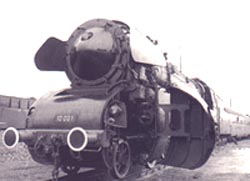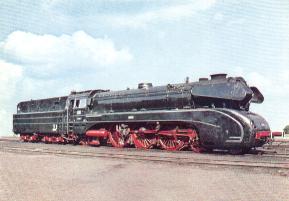BR 10
BR 10
In service
BR 10
The steam engine BR 10 is obvious the result of wrong expectations. The railways were changing in a fast way in the fifties and sixties. At the beginning of the fifties the railway directors thought for example that due to rising of the number of express trains the need for fast express train steam engines was also rising. New steam engines had to replace the old DRG steam engine types. But due to the electrifying of the mainlines and new modern diesel locomotives, the need for steam engines was go down quickly. These developments were not predictable at the beginning of the fifties.
The express train steam engines of the series BR 10 were the first (and also the last) new steam engines built by the Deutsche Bundesbahn. The BR 10 had to replace the series BR 01.10 and BR 03.10. They wanted to replace these steam engines by a powerful and lightweight 1'C1'h2 steam engine.
In 1950 the HVB in Offenbach instructed the Eisenbahnzentralamt (EZA) in Göttingen to design a new steam engine. They had to comply with an exact performance program which was laid down. For example they required that the locomotive had an axle load of 20 ton and a maximum speed of 130 km/u.
Already August 1950 the EZA presented together with the German locomotive industry the first proposals. The steam engine was able to pull a train of 420 ton with a speed of 130 km/h on a flat land. The increase of the speed from 130 km/h to 140 km/h was only achieved by enlarging the driving wheels from 2000 mm to 2200 mm.
In September 1950 the HVB asked for a new design. The locomotive, in the meantime indicated as BR 10, had finally a total weight of 66 ton and an axle load of 22 ton.
 | | Movable cilinder coverage of the BR 10 locomotive |
Also the German locomotive industry brought forward new proposals for the new steam engine, but finally they chose for the design of the EZA.
In the meantime it was clear that the new locomotive had to pull express trains of 300 ton with speeds of 140 km/h. The steam engines were built as three cylinder engines with driving wheels of 2000 mm diameter. Eventually the steam engines got an axle arrangement of 2'C1' instead of 1'C1'. Due to the high axle load of 22 ton, this reduced the lines were they had service, because not all lines were able to run at speeds of 140 km/h. The boilers were the same sort of boilers as the boilers of the 01/01.10 steam engines, but were not interchangeable.
The steam engines BR 10 were semi streamlined. The streamline plates enclosed the cylinders, which were reachable by covers which could be folded. The streamline plates were painted with elegant lines. The smoke box door was conical shaped.
In service
In 1956 Krupp delivered the 10 001 and in January 1957 they delivered the 10 002. Both steam engines were oil burned. Only the 10 001 had a system which made use of an airstream through the firebed to get higher efficiency of lower grade burning materials. With this system the material burns faster so the gas produced by the fire get hotter than with normal burning. The 10 002 was completely oil firing, and had not such system as the 10 001. Because both steam engines had different systems, they had also two different tenders. The 10 001 was stationed for a year at the "lokomotiv versuchsansalt" (locomotive test station) in Minden. Next both steam engines were going to the AW Mülheim-Speldorf.
 | |
The two steam engines BR 10 went into service in March 1958 from the Bw Bebra, from where they had their service on the "Nord-Süd Strecke" on the relations Hannover, Kassel and Frankfurt (Main). The locomotives were running in the express train services together with locomotives of the series BR 01.10. Also long runs between Hannover/Lüneberg and Würzburg/Ingolstadt belonged to their program. With the first main overhaul the BR 10 001 was changed completely to oil burning, this was done in the AW Braunschweig in 1959. Due to the further electrifying of the mainlines, the locomotives moved to the Bw Kassel on 20 September 1962. Here they had their service first in express trains but later they were pulling only "eilzüge" between Kassel and Münster and Rheine.
After all only these two locomotives are built because due to the modernising of the railways there was no need any longer for this sort of steam engines. Due to damage to the driving wheels and the shrinkage of their service area the 10 002 was first taken out of service in January 1967, a year later followed by the 10 001.
The 10 002 was used until April 1971 as locomotive to heat passenger trains in the Hbf Ludwigshafen. Finally this one was taken out of service in 1972 in the AW Offenburg. The 10 001 was preserved initially for the planned railway museum in western Berlin, but in 1976 it was finally going to the "Deutsche Dampflokmuseum" in Neuenmarkt-Wirsberg. The steam engine is now in an excellent condition and is still standing in this museum.
| Axle layout: |
2'C1'h3 |
| In service: |
1958 |
| Diameter driving wheels: |
200 cm |
| Diameter carrying wheels: |
100 cm/100 cm |
Lengte over de buffers
(met tender 2'2 T40): |
26,503 m |
| Top speed: |
140 km/h |
| Power: |
2500 pk/hp |
| Boiler pressure: |
18 bar |
| Weight: |
118,9 t |
|
